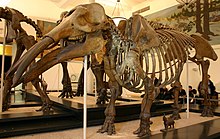Gomphothere
| Gomphotheres | |
|---|---|

| |
| Gomphotherium | |
| Scientific classification | |
| Kingdom: | |
| Class: | |
| Order: | |
| Family: | Gomphotheriidae
|

The Gomphotheres were a varied family of extinct elephant-like animals (proboscidea).[1] The early species had four tusks, and scratches on the teeth suggest they ate rough vegetable matter.
They had a wide distribution. They were common in North America during the Miocene and Pliocene epochs, 12–1.6 million years ago. Some lived in parts of Eurasia, Beringia and, after the Great American Interchange, South America.[2]
Beginning about five million years ago, they were gradually replaced by modern elephants. The last two South American species, in the genus Cuvieronius, did not become extinct until about 9000 years ago.[3] Stegomastodon remains have been dated as recently as 6,000 years ago in the Valle del Magdalena, Colombia.
Gomphotheres survived in Mexico and Central America until the end of the Pleistocene.
The arrival of mankind in the Americas about 11,000 years ago is generally credited for the loss of large species of all kinds of animals. The details of this are unknown.

The relationship between the Gomphotheres and modern elephants is also unknown. The similarities might be due to descent, or might be due to parallel evolution, that is, to similar lifestyles.
References
[change | change source]- ↑ Shoshani, Jeheskel & Pascal Tassy 2005. Advances in proboscidean taxonomy & classification, anatomy & physiology, and ecology & behavior. Quaternary International. 126-128: 5–20. [1]
- ↑ "The Gomphotheriidae". University of California Museum of Paleontology. [2]
- ↑ Rafael O. Labarca and Patrick G. Lopez 2006. Los mamíferos finipleistocénicos de la Formación Quebrada Quereo (IV Región-Chile): biogeografía, bioestratigrafía e inferencias paleoambientales. Mastozoología Neotropical, 13 (1), 89-101
